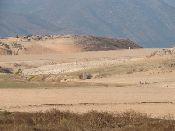|
Major stakeholders
The first and major users involved in natural resource management and desertification are the Regione Basilicata, in particular the regional agency ALSIA, Consorzio di bonifica del Vulture e Alto Bradano (CBV) and the Autorità di Bacino del Fiume Ofanto, which coincide with the Autorità di Bacino della Puglia(AbP). The first two showed an immediate interest in our project. They are our main two stakeholders at watershed scale.
- ALSIA (Agenzia Lucana di Sviluppo e di Innovazione in Agricoltura) – Department of services for agricultural development , Experimental Farm GAUDIANO, SS.93 Km 44.5 GAUDIANO (PZ). Email:
This e-mail address is being protected from spambots. You need JavaScript enabled to view it
; Website: http://www.alsia.it. ALSIA is main regional agency of the Basilicata Region for the agricultural and food processing system and responsible for extension services and completion of Agrarian Reform. The role of the agency has been established by Regional Law n. 38/96, and integrated by other regional Law: No. 21/98, 61/00 and 29/01.
- Consorzio di Bonifica Vulture - Alto Bradano; Piazza S.M.Assunta - 85020 Gaudiano PZ. E-mail:
This e-mail address is being protected from spambots. You need JavaScript enabled to view it
. Public consortium. Total surface: 2000 km² (including Rendina Basin). Public institution, established under National Law (regio decreto 13 febbraio 1933 n. 215) to coordinate public intervention and private activities in matter of land reclamation. Competences of the consortium are Hydraulic structures, and Water management for irrigation. The consortium is responsible for the management of the Rendina Dam (Lavello–PZ).
Local technical schools (agrarian/environmental) contacted for dissemination activity (seminars initiated in the 2008) :
- Agrarian and Environmental Professional Insitute. Genzano di Lucania (Potenza) Italy
- Agrarian Technical State Institute Lavello (Potenza) Italy
Land users. There are several local representatives of the national farmer association and farmer’s unions working locally to support associated farmers in various aspect related to agricultural development and promotion of local production, technical, legislative, fiscal assistance, EU policy implementation and relationships with National and regional authorities and policies. The main farmer associations are:
- CIA (Confederazione Italiana Agricoltori): Italian farmer association with 900.000 members at national level and with capillary distribution at local regional scale. Founded in the 1977. Local representative is CIA-BASILICATA; Via Pascoli, 25 , 85024 Lavello http://www.ciabasilicata.org (link expired). A branch of CIA is AGIA -Associazione dei Giovani Imprenditori Agricoli (young farmers association; www.agia.it)
- COLDIRETTI (www.coldiretti.it): Italian farmer association at National level and with capillary distribution at local regional scale. Founded in the 1946. Based fundamentally on Christian Catholic principles.
- COPAGRI (Confederazione Produttori Agricoli): farmers’s union fonded in the 1990’s, that has regional and provincial distribution in Basilicata (http://www.ssabasilicata.it/COPAGRI).
Note: The farmers' willingness to cooperate with the DESIRE project in a formal way was really low, since they declared themselves not available for meetings, questionnaires and other time-keeping activities. Therefore, in order to collect the information necessary for the project's aims, some farmers were contacted and interviewed in an informal way, sometimes in the field. Only in February 2008 and November 2008 were two meetings with a small number of selected users organised, with the aim of finding ways to raise the interest of larger groups of users (including farmers). These workshops were promoted with the support of the CBV and ALSIA organizations.
Sustainability Goals
| Goal 1 |
Conservation and maintenance of soil and water resources |
| Goal 2 |
Maintenance of forest ecosystem and vitality with special regards to functionality to preserve groundwater recharge and water quality |
| Goal 3 |
Maintenance of ecosystem through guided adaptation to climatic changes |
| Goal 4 |
Suggest improvement and adaptation of current policy and legal tools in order to tackle future trends involving soil and water conservation |
| Goal 5 |
Suggest solution to present contradictions in soil conservation regional policies |
Source: expert estimate, study site leader.
|



